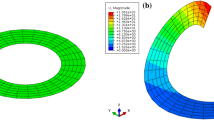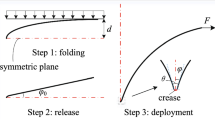Abstract
Compared with the conventional rigid origami, the flexible origami has larger deformation and more complicated mechanical property and nonlinear problems due to self-contact and friction. In this paper, the nonlinear dynamic formulation for flexible origami-based deployable structures considering self-contact and friction is investigated. Firstly, a symmetric rigid origami model is presented based on the forward recursive formulation without the inclusion of contact, and then, a discretized dynamic model for flexible origami structures is established by using thin plate element of absolute nodal coordinate formulation. To consider the normal contact, the penalty method is adopted to enforce the nonpenetration condition. In order to improve the precision and applicability, a modified mixed contact method considering the friction effect is developed by integrating the advantages of node-to-surface, edge-to-surface and surface-to-surface contact elements. This proposed method can effectively avoid the mutual penetration of different corner nodes, element edges and contact element surfaces. Moreover, the tangential friction model considering the stick–slip transition and large sliding is established by the regularized Coulomb friction law. A series of numerical examples validate the effectiveness of the proposed mixed contact method considering the friction and show the advantage of the flexible model compared with the rigid origami model. Furthermore, the nonlinear performance of the flexible origami-based deployable structures due to the contact and friction is revealed.
























Similar content being viewed by others
Availability of data and material
All the data related to the current work are available when required.
Code availability
The custom codes cannot be shared for this time as they are related to another ongoing study.
References
Wang, Z., Jing, L., Yao, K., Yang, Y., Zheng, B., Soukoulis, C.M., Chen, H., Liu, Y.: Origami-based reconfigurable metamaterials for tunable chirality. Adv. Mater. 29(27), 1700412 (2017). https://doi.org/10.1002/adma.201700412
Liu, C., Tian, Q., Yan, D., Hu, H.: Dynamic analysis of membrane systems undergoing overall motions, large deformations and wrinkles via thin shell elements of ANCF. Comput. Meth. Appl. Mech. Eng. 258, 81–95 (2013)
Arya, M., Webb, D., McGown, J., Lisman, P.D., Shaklan, S., Bradford, S.C., Steeves, J., Hilgemann, E., Trease, B., Thomson, M., Warwick, S., Freebury, G., Gull, J.: Starshade mechanical design for the Habitable Exoplanet imaging mission concept (HabEx). In: SPIE Optical Engineering + Applications, San Diego, Chile 2017
Baek, S.-M., Yim, S., Chae, S.-H., Lee, D.-Y., Cho, K.-J.: Ladybird beetle–inspired compliant origami. Sci. Robot. (2020). https://doi.org/10.1126/scirobotics.aaz6262
Zhang, Z., Chen, G., Wu, H., Kong, L., Wang, H.: A pneumatic/cable-driven hybrid linear actuator with combined structure of origami chambers and deployable mechanism. IEEE Robot. Autom. Lett. 5(2), 3564–3571 (2020). https://doi.org/10.1109/LRA.2020.2976324
Fang, J., Yuan, J., Wang, M., Xiao, L., Yang, J., Lin, Z., Xu, P., Hou, L.: Novel accordion-inspired foldable pneumatic actuators for knee assistive devices. Soft Robot. 7(1), 95–108 (2020). https://doi.org/10.1089/soro.2018.0155
You, Z.: Folding structures out of flat materials. Science 345(6197), 623–624 (2014). https://doi.org/10.1126/science.1257841
Xiang, X.M., Lu, G., You, Z.: Energy absorption of origami inspired structures and materials. Thin-Walled Struct. 157, 107130 (2020). https://doi.org/10.1016/j.tws.2020.107130
Peraza Hernandez, E., Hartl, D., Lagoudas, D.: Active origami: modeling, design, and applications. Springer, Cham (2018)
Belcastro, S., Hull, T.C.: Modelling the folding of paper into three dimensions using affine transformations. Linear Algebra Appl. 348(1), 273–282 (2002). https://doi.org/10.1016/S0024-3795(01)00608-5
Tachi, T.: Simulation of rigid origami. In: Lang, R.J. (ed.) Origami 4: Fourth International Meeting of Origami Science, Mathematics, and Education. pp. 175–187. (2009)
Tachi, T.: Geometric considerations for the design of rigid origami structures. In: Proceedings of the International Association for Shell and Spatial Structures (IASS) Symposium, Shanghai, China (2010)
Feng, H., Peng, R., Ma, J., Chen, Y.: Rigid foldability of generalized triangle twist origami pattern and its derived 6R linkages. J. Mech. Robot. 10, 051003 (2018). https://doi.org/10.1115/1.4040439
Liu, Z., Qiu, H., Li, X., Yang, S.: Review of large spacecraft deployable membrane antenna structures. Chin. J. Mech. Eng. 30(6), 1447–1459 (2017)
Cai, J., Ren, Z., Ding, Y., Deng, X., Xu, Y., Feng, J.: Deployment simulation of foldable origami membrane structures. Aerosp. Sci. Technol. 67, 343–353 (2017)
Miguel, E., Tamstorf, R., Bradley, D., Schvartzman, S.C., Thomaszewski, B., Bickel, B., Matusik, W., Marschner, S., Otaduy, M.A.: Modeling and estimation of internal friction in cloth. ACM Trans. Gr. 32(6), 212 (2013). https://doi.org/10.1145/2508363.2508389
Ma, J., Feng, H., Chen, Y., Hou, D., You, Z.: Fold. Tubular Waterbomb. Res. 2020, 1735081 (2020). https://doi.org/10.34133/2020/1735081
Ma, J., Zang, S., Feng, H., Chen, Y., You, Z.: Theoretical characterization of a non-rigid-foldable square-twist origami for property programmability. Int. J. Mech. Sci. 189, 105981 (2021). https://doi.org/10.1016/j.ijmecsci.2020.105981
Yuan, L., Dai, H., Song, J., Ma, J., Chen, Y.: The behavior of a functionally graded origami structure subjected to quasi-static compression. Mater. Des. 189, 108494 (2020). https://doi.org/10.1016/j.matdes.2020.108494
Liu, K., Paulino, G.H.: Nonlinear mechanics of non-rigid origami: an efficient computational approach. Proceedings of the Royal Society A: Mathematical, Physical and Engineering Sciences. (2017). https://doi.org/10.1098/rspa.2017.0348
Xu, Y., Guan, F.: Fold methods and deployment analysis of deployable membrane structure. Eng. Mech. 25(5), 176–181 (2008)
Fang, H., Wang, K.W., Li, S.: Asymmetric energy barrier and mechanical diode effect from folding multi-stable stacked-origami. Extreme Mech. Lett. 17, 7–15 (2017). https://doi.org/10.1016/j.eml.2017.09.008
Zhang, Q., Fang, H., Xu, J.: Programmable stopbands and supratransmission effects in a stacked Miura-origami metastructure. Phys. Rev. E 101(4), 042206 (2020). https://doi.org/10.1103/PhysRevE.101.042206
Shabana, A.A.: Flexible multibody dynamics: review of past and recent developments. Multibody Syst. Dyn. 1(2), 189–222 (1997)
Dufva, K., Shabana, A.A.: Analysis of thin plate structures using the absolute nodal coordinate formulation. Proc. Inst. Mech. Eng., Part K J. Multi-body Dyn. 219(4), 345–355 (2005). https://doi.org/10.1243/146441905x50678
Dmitrochenko, O., Mikkola, A.: Two simple triangular plate elements based on the absolute nodal coordinate formulation. J. Comput. Nonlinear Dyn. 3(4),(2008)
Ren, H.: Fast and robust full-quadrature triangular elements for thin plates/shells with large deformations and large rotations. J. Comput. Nonlinear Dyn. 10(5), 051018 (2015). https://doi.org/10.1115/1.4030212
Sun, D., Liu, C., Hu, H.: Dynamic computation of 2D segment-to-segment frictionless contact for a flexible multibody system subject to large deformation. Mech. Mach. Theory 140, 350–376 (2019). https://doi.org/10.1016/j.mechmachtheory.2019.06.011
Yuan, T., Liu, Z., Zhou, Y., Liu, J.: Dynamic modeling for foldable origami space membrane structure with contact-impact during deployment. Multibody Syst. Dyn. 50(1), 1–24 (2020). https://doi.org/10.1007/s11044-020-09737-x
Flores, P., Ambrósio, J., Claro, J.C.P., Lankarani, H.M.: Influence of the contact—impact force model on the dynamic response of multi-body systems. Proc. Inst. Mech. Eng. Part K J. Multi-body Dyn. 220(1), 21–34 (2006). https://doi.org/10.1243/146441906x77722
Kikuuwe, R., Takesue, N., Sano, A., Mochiyama, H., Fujimoto, H.: Fixed-step friction simulation: from classical Coulomb model to modern continuous models. In: 2005 IEEE/RSJ International Conference on Intelligent Robots and Systems, United States, pp. 1009–1016 (2005)
Pennestrì, E., Rossi, V., Salvini, P., Valentini, P.P.: Review and comparison of dry friction force models. Nonlinear Dyn. 83(4), 1785–1801 (2016). https://doi.org/10.1007/s11071-015-2485-3
Cha, H.-Y., Choi, J., Ryu, H.S., Choi, J.H.: Stick-slip algorithm in a tangential contact force model for multi-body system dynamics. J. Mech. Sci. Technol. 25(7), 1687–1694 (2011). https://doi.org/10.1007/s12206-011-0504-y
Yu, L., Zhao, Z., Tang, J., Ren, G.: Integration of absolute nodal elements into multibody system. Nonlinear Dyn. 62(4), 931–943 (2010). https://doi.org/10.1007/s11071-010-9775-6
Yu, L., Zhao, Z., Ren, G.: Multibody dynamic model of web guiding system with moving web. J. Dyn. Syst. Meas. Contr. 132(5), 051004 (2010). https://doi.org/10.1115/1.4001797
MSC.Software: Adams/View help. (2012)
Sun, D., Liu, C., Hu, H.: Dynamic computation of 2D segment-to-segment frictional contact for a flexible multibody system subject to large deformations. Mech. Mach. Theory 158, 104197 (2021). https://doi.org/10.1016/j.mechmachtheory.2020.104197
Benson, D.J., Hallquist, J.O.: A single surface contact algorithm for the post-buckling analysis of shell structures. Comput. Meth. Appl. Mech. Eng. 78(2), 141–163 (1990). https://doi.org/10.1016/0045-7825(90)90098-7
Konyukhov, A., Schweizerhof, K.: Computational Contact Mechanics: Geometrically Exact Theory for Arbitrary Shaped Bodies. Computational Contact Mechanics. Springer, . Berlin (2013)
Konyukhov, A., Izi, R.: Introduction To Computational Contact Mechanics: A Geometrical Approach Wiley Series In Computational Mechanics. Wiley, New York (2015)
Bae, D.-S., Haug, E.J.: A recursive formulation for constrained mechanical system dynamics: part I open loop systems. Mech. Struct. Mach. 15(3), 359–382 (1987). https://doi.org/10.1080/08905458708905124
Hong, J.: Computational Dynamics of Multibody Systems. Higher Education Press, Beijing (1999)
Peraza Hernandez, E.A., Hartl, D.J., Lagoudas, D.C.: Active Origami: Modeling, Design, and Applications. Springer International Publishing, Cham (2019)
De Focatiis, D.S.A., Guest, S.D.: Deployable membranes designed from folding tree leaves. Philosophical transactions of the royal society of london series A: mathematical. Phys. Eng. Sci. 360(1791), 227–238 (2002)
Dmitrochenko, O.N., Pogorelov, D.Y.: Generalization of plate finite elements for absolute nodal coordinate formulation. Multibody Sys.Dyn. 10(1), 17–43 (2003)
Gerstmayr, J., Sugiyama, H., Mikkola, A.: Review on the absolute nodal coordinate formulation for large deformation analysis of multibody systems. J. Comput. Nonlinear Dyn. 8(3), 031016 (2013). https://doi.org/10.1115/1.4023487
Hyldahl, P., Mikkola, A.M., Balling, O., Sopanen, J.T.: Behavior of thin rectangular ANCF shell elements in various mesh configurations. Nonlinear Dyn. 78(2), 1277–1291 (2014). https://doi.org/10.1007/s11071-014-1514-y
Konyukhov, A., Schweizerhof, K.: Geometrically exact covariant approach for contact between curves. Comput. Meth. Appl. Mech. Eng. 199(37), 2510–2531 (2010). https://doi.org/10.1016/j.cma.2010.04.012
Konyukhov, A., Schweizerhof, K.: Contact formulation via a velocity description allowing efficiency improvements in frictionless contact analysis. Comput. Mech. 33(3), 165–173 (2004)
Eberhard, P.: Kontaktuntersuchungen durch hybride Mehrkörpersystem/Finite Elemente Simulationen. Shaker Verlag, Aachen (2000)
Tang, L., Liu, J.: Frictional contact analysis of sliding joints with clearances between flexible beams and rigid holes in flexible multibody systems. Multibody Sys.Dyn. 49(2), 155–179 (2019). https://doi.org/10.1007/s11044-019-09717-w
Schweizerhof, K., Konyukhov, A.: Covariant description for frictional contact problems. Comput. Mech. 35(3), 190–213 (2005). https://doi.org/10.1007/s00466-004-0616-7
Géradin, M., Cardona, A.: Flexible Multibody Dynamics: A Finite Element Approach. Wiley, Chichester (2001)
Arnold, M., Brüls, O.: Convergence of the generalized-α scheme for constrained mechanical systems. Multibody Sys.Dyn. 18(2), 185–202 (2007). https://doi.org/10.1007/s11044-007-9084-0
Shi, J., Liu, Z., Hong, J.: Dynamic contact model of shell for multibody system applications. Multibody Sys.Dyn. 44(4), 335–366 (2018)
Morgan, J., Magleby, S.P., Howell, L.L.: An approach to designing origami-adapted aerospace mechanisms. J. Mech. Des. (2016). https://doi.org/10.1115/1.4032973
Yuan, T., Liu, J.: Dynamic modelling for the deployment of the folded membrane structure with self-contact. In: The 9th ECCOMAS Thematic Conference on Multibody Dynamics, Duisburg, Germany 2019
Jrusjrungkiat, A.: Nonlinear Analysis of Pneumatic Membranes: From Subgrid to Interface. Technical University of Munich (2009)
Haug, E.J.: Computer Aided Kinematics and Dynamics of Mechanical Systems. Springer, Berlin (1984)
Acknowledgements
This research was supported by General Program (Nos. 11772186, 11772188) of the National Natural Science Foundation of China and the Key Program (No. 11932001) of the National Natural Science Foundation of China, for which the authors are grateful. This research was also supported by the Key Laboratory of Hydrodynamics (Ministry of Education).
Author information
Authors and Affiliations
Corresponding author
Ethics declarations
Conflicts of interest
The authors declare that they have no conflicts of interest to this work.
Additional information
Publisher's Note
Springer Nature remains neutral with regard to jurisdictional claims in published maps and institutional affiliations.
Appendices
Appendix 1
The shape function matrix \({\mathbf{S}}_{A}\) for triangular thin plate element is given by
The shape functions are as follows
where \(P_{i} = \Delta_{i}^{2} \Delta_{j} + {{\Delta_{i} \Delta_{j} \Delta_{k} \left[ {3\left( {1 - \mu_{k} } \right)\Delta_{i} + \left( {1 + 3\mu_{k} } \right)\left( {\Delta_{k} - \Delta_{j} } \right)} \right]} \mathord{\left/ {\vphantom {{\Delta_{i} \Delta_{j} \Delta_{k} \left[ {3\left( {1 - \mu_{k} } \right)\Delta_{i} + \left( {1 + 3\mu_{k} } \right)\left( {\Delta_{k} - \Delta_{j} } \right)} \right]} 2}} \right. \kern-\nulldelimiterspace} 2}\), \(\mu_{i} = {{\left( {l_{k}^{2} - l_{j}^{2} } \right)} \mathord{\left/ {\vphantom {{\left( {l_{k}^{2} - l_{j}^{2} } \right)} {l_{i}^{2} }}} \right. \kern-\nulldelimiterspace} {l_{i}^{2} }}\), \(l_{i}^{2} = c_{i1}^{2} + c_{i2}^{2}\). In addition, \(\Delta_{i} {\kern 1pt} {\kern 1pt} (i = 1,2,3)\) and \(c_{ij} {\kern 1pt} (i,j = 1,2,3)\) are triangular area coordinates and area coefficients, respectively.
Appendix 2
The shape function matrix \({\mathbf{S}}_{B}\) for rectangular thin plate element is written as
The shape functions are as follows
where \(\xi = {x \mathord{\left/ {\vphantom {x {a_{e} }}} \right. \kern-\nulldelimiterspace} {a_{e} }},\;\eta = {y \mathord{\left/ {\vphantom {y {b_{e} }}} \right. \kern-\nulldelimiterspace} {b_{e} }}\;\;(0 \le \xi ,\eta \le 1)\). \(a_{e}\) and \(b_{e}\) are the lengths of the rectangular element in the direction of x and y, respectively.
Rights and permissions
About this article
Cite this article
Yuan, T., Tang, L., Liu, Z. et al. Nonlinear dynamic formulation for flexible origami-based deployable structures considering self-contact and friction. Nonlinear Dyn 106, 1789–1822 (2021). https://doi.org/10.1007/s11071-021-06860-y
Received:
Accepted:
Published:
Issue Date:
DOI: https://doi.org/10.1007/s11071-021-06860-y




